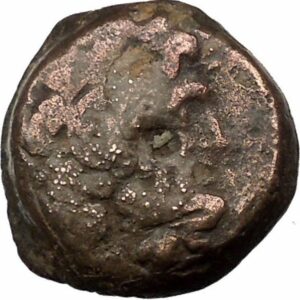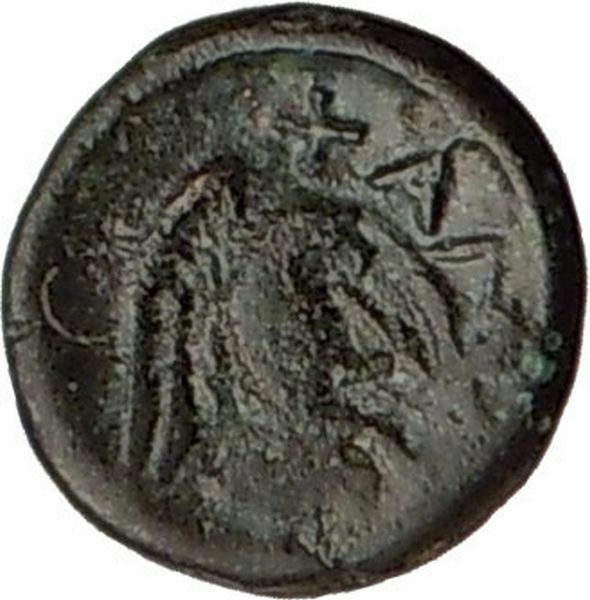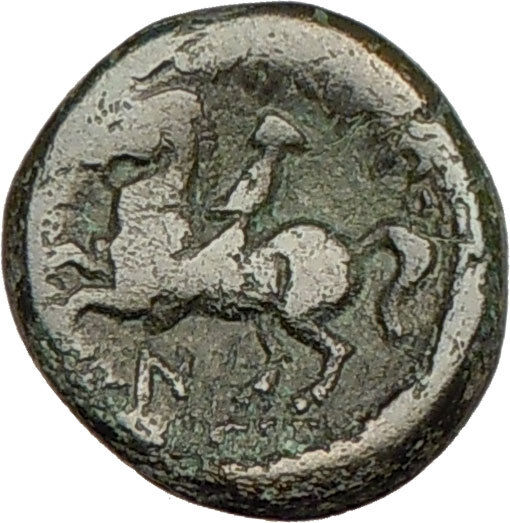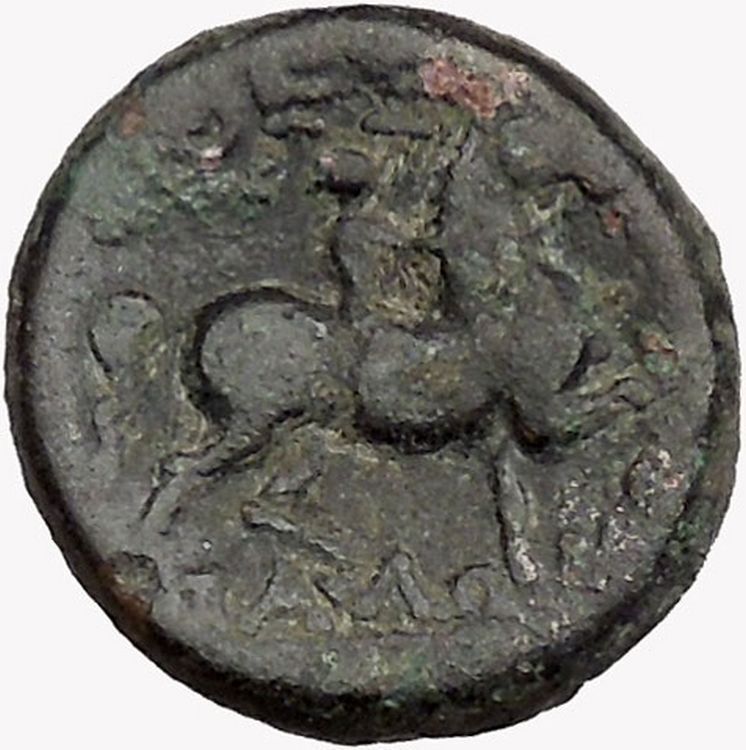|
Greek city of Ainos in Thrace (Northern Greece)
Bronze 20mm (6.22 grams) Struck circa 280-200 B.C.
Reference: Sear 1574 var.
Head of Hermes left, wearing wide petasos.
Caduceus; A-I / N-I / O-N in field, head of ram to right.
Ainos was a prosperous city and trading center, situated on a
peninsula at the mouth of the river Hebros.
You are bidding on the exact item pictured,
provided with a Certificate of Authenticity and Lifetime Guarantee of
Authenticity.
The caduceus from
Greek “herald’s staff” is the staff carried by
Hermes in
Greek mythology. The same staff was also borne
by heralds in general, for example by
Iris, the messenger of
Hera. It is a short staff entwined by two
serpents, sometimes surmounted by wings. In
Roman iconography it was often depicted being carried in the left hand of
Mercury, the messenger of the gods, guide of
the dead and protector of merchants, shepherds, gamblers, liars, and thieves.
As a symbolic object it represents Hermes (or the Roman Mercury), and by
extension trades, occupations or undertakings associated with the god. In later
Antiquity the caduceus provided the basis for
the
astrological symbol representing the
planet Mercury. Thus, through its use in
astrology and
alchemy, it has come to denote the
elemental metal of the same name.
By extension of its association with Mercury/Hermes, the caduceus is also a
recognized symbol of commerce and negotiation, two realms in which balanced
exchange and reciprocity are recognized as ideals.
This association is ancient, and consistent from the Classical period to modern
times. The caduceus is also used as a symbol representing printing, again by
extension of the attributes of Mercury (in this case associated with writing and
eloquence).
The caduceus is sometimes mistakenly used
as a symbol of medicine and/or medical practice,
especially in
North America, because of widespread confusion
with the traditional medical symbol, the
rod of Asclepius, which has only a single snake
and no wings.
The term kerukeion denoted any herald’s staff, not necessarily
associated with Hermes in particular.
Lewis Richard Farnell (1909) in his study of
the cult of Hermes assumed that the two snakes had simply developed out of
ornaments of the shepherd’s crook used by heralds as their staff.
This view has been rejected by later authors pointing to parallel iconography in
the Ancient Near East. It has been argued that the staff or wand entwined by two
snakes was itself representing a god in the pre-anthropomorphic era. Like the
herm or
priapus, it would thus be a predecessor of the
anthropomorphic Hermes of the classical era.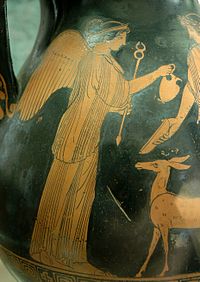
Ancient Near East
William Hayes Ward (1910) discovered that
symbols similar to the classical caduceus sometimes appeared on
Mesopotamian cylinder seals. He suggested the
symbol originated some time between 3000 and 4000 BCE, and that it might have
been the source of the Greek caduceus.[10]
A.L. Frothingham incorporated Dr. Ward’s research into his own work, published
in 1916, in which he suggested that the prototype of Hermes was an “Oriental
deity of Babylonian extraction” represented in his earliest form as a snake god.
From this perspective, the caduceus was originally representative of Hermes
himself, in his early form as the Underworld god
Ningishzida, “messenger” of the “Earth Mother”.
The caduceus is mentioned in passing by
Walter Burkert[12]
as “really the image of copulating snakes taken over from Ancient Near Eastern
tradition”.
In Egyptian iconography, the
Djed pillar is depicted as containing a snake in a frieze of the
Dendera Temple complex.
The rod of
Moses and the
brazen serpent are frequently compared to the
caduceus, especially as Moses is acting as a messenger of God to the
Pharaoh at the point in the narrative where he
changes his staff into a serpent.[13]
Classical antiquity
Mythology
The
Homeric hymn to Hermes relates how Hermes
offered his lyre fashioned from a tortoise shell as compensation for the
cattle he stole from his half brother
Apollo. Apollo in return gave Hermes the
caduceus as a gesture of friendship.
The association with the serpent thus connects Hermes to
Apollo, as later the serpent was associated
with
Asclepius, the “son of Apollo”.
The association of Apollo with the serpent is a continuation of the older
Indo-European
dragon-slayer motif.
Wilhelm Heinrich Roscher (1913) pointed out
that the serpent as an attribute of both Hermes and Asclepius is a variant of
the “pre-historic semi-chthonic serpent hero known at Delphi as
Python”, who in classical mythology is slain by
Apollo.
One Greek
myth of origin of the caduceus is part of the
story of
Tiresias,
who found two snakes copulating and killed the female with his staff. Tiresias
was immediately turned into a woman, and so remained until he was able to repeat
the act with the male snake seven years later. This staff later came into the
possession of the god Hermes, along with its transformative powers.
Another myth suggests that Hermes (or Mercury) saw two serpents entwined in
mortal combat. Separating them with his wand he brought about peace between
them, and as a result the wand with two serpents came to be seen as a sign of
peace.
In Rome,
Livy refers to the caduceator who
negotiated peace arrangements under the diplomatic protection of the caduceus he
carried.
Iconography
In some vase paintings ancient depictions of the Greek kerukeion are
somewhat different from the commonly seen modern representation. These
representations feature the two snakes atop the staff (or rod), crossed to
create a circle with the heads of the snakes resembling horns. This old graphic
form, with an additional crossbar to the staff, seems to have provided the basis
for the graphical
sign of Mercury (☿) used in
Greek astrology from Late Antiquity.
Use in alchemy
and occultism
As the symbol of both the
planet and the
metal named for Mercury, the caduceus became an
important symbol in
alchemy.
The
crucified serpent was also revived as an
alchemical symbol for
fixatio, and
John Donne (Sermons 10:190) uses
“crucified Serpent” as a title of
Jesus Christ.
Symbol of commerce
A simplified variant of the caduceus is to be found in dictionaries,
indicating a “commercial term” entirely in keeping with the association of
Hermes with commerce. In this form the staff is often depicted with two winglets
attached and the snakes are omitted (or reduced to a small ring in the middle).
The Customs Service of the former
German Democratic Republic employed the
caduceus, bringing its implied associations with thresholds, translators, and
commerce, in the service medals they issued their staff.
Misuse as symbol
of medicine
It is relatively common, especially in the United States, to find the
caduceus, with its two snakes and wings, used as a symbol of medicine instead of
the correct rod of Asclepius, with only a single snake. This usage is erroneous,
popularised largely as a result of the adoption of the caduceus as its insignia
by the
US Army medical corps in 1902 at the insistence
of a single officer (though there are conflicting claims as to whether this was
Capt. Frederick P. Reynolds or Col. John R. van Hoff).
The rod of Asclepius is the dominant symbol for professional healthcare
associations in the United States. One survey found that 62% of professional
healthcare associations used the rod of Asclepius as their symbol.
The same survey found that 76% of commercial healthcare organizations used the
Caduceus symbol. The author of the study suggests the difference exists because
professional associations are more likely to have a real understanding of the
two symbols, whereas commercial organizations are more likely to be concerned
with the visual impact a symbol will have in selling their products.
The initial errors leading to its adoption and the continuing confusion it
generates are well known to medical historians. The long-standing and abundantly
attested historical associations of the caduceus with commerce, theft,
deception, and death are considered by many to be inappropriate in a symbol used
by those engaged in the healing arts.
This has occasioned significant criticism of the use of the caduceus in a
medical context.
Aenus modern
Enez in
Turkey,
was an
ancient Greek city on the southeastern coast of
Thrace.
Formerly called Poltyobria (or Poltymbria), it was located near
the mouth of the
Hebrus River, not far from the Melas Gulf (modern
Gulf
of Saros), which is formed by the Thracian Chersonesus to the east. The city
was said to be founded (or at least settled) by
Aeolian
migrants from
Lesbos.
Aenus is mentioned by several ancient authors (e.g., Homer, Strabo,
Apollodorus, Thucydides), and makes several appearances in
Greek mythology. Its mythical and eponymous founder was said to be
Aeneus, a son of the god
Apollo and
father of
Cyzicus. Another mythical ruler, named
Poltys, son of
Poseidon,
entertained
Heracles when he came to Aenus. On that occasion, Heracles slew Poltys’
insolent brother
Sarpedon on
the beach of Aenus. According to Strabo, Sarpedon is the name of the coastline
near Aenus, so both Poltys and Sarpedon would appear to be eponyms.
In the
Iliad,
Homer mentions
that the leaders of Troy’s
Thracian
allies,
Acamas
and
Peiros,
came from Aenus.
Hermes is the great messenger of the gods in
Greek mythology and additionally as a
guide to
the Underworld. Hermes was born on
Mount
Cyllene in Arcadia. An
Olympian god,
he is also the patron of boundaries and of the travelers who cross them, of
shepherds
and
cowherds, of the
cunning
of thieves and liars, of orators and wit, of literature and poets, of athletics
and sports, of weights and measures, of invention, and of commerce in general.
His symbols include the tortoise, the rooster, the winged sandals, the winged
hat, and the
caduceus (given to him by Apollo in exchange for the lyre).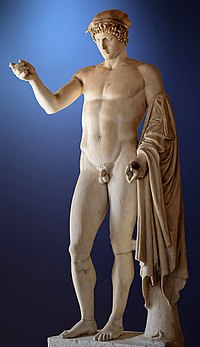
In the Roman adaptation of the Greek religion (see
interpretatio romana), Hermes was identified with the Roman god
Mercury, who, though inherited from the
Etruscans, developed many similar characteristics, such as being the patron
of commerce.
The
Homeric hymn to Hermes invokes him as the one “of many shifts (polytropos),
blandly cunning, a robber, a cattle driver, a bringer of dreams, a watcher by
night, a thief at the gates, one who was soon to show forth wonderful deeds
among the deathless gods.”
He protects and takes care of all the travelers, miscreants, harlots, old
crones and
thieves that pray to him or cross his path. He is athletic and is always looking
out for runners, or any athletes with injuries who need his help.
Hermes is a messenger from the gods to humans, sharing this role with
Iris.
An interpreter who bridges the boundaries with strangers is a hermeneus.
Hermes gives us our word “hermeneutics”,
the study and theory of interpretation. In Greek a lucky find was a hermaion.
Hermes delivered messages from Olympus to the mortal world. He wears shoes with
wings on them and uses them to fly freely between the mortal and immortal world.
Hermes was the second youngest of the
Olympian gods, being born before
Dionysus.
Hermes, as an inventor of fire, is a parallel of the
Titan,
Prometheus.
In addition to the
lyre,
Hermes was believed to have invented many types of racing and the sports of
wrestling and boxing, and therefore was a patron of athletes.
According to prominent
folklorist
Yeleazar
Meletinsky, Hermes is a deified
trickster.
Hermes also served as a
psychopomp,
or an escort for the dead to help them find their way to the
afterlife
(the
Underworld in the Greek myths). In many Greek myths, Hermes was depicted as
the only god besides
Hades,
Persephone,
Hecate, and
Thanatos who could enter and leave the Underworld without hindrance.
Hermes often helped travelers have a safe and easy journey. Many Greeks would
sacrifice to Hermes before any trip.
In the fully-developed Olympian pantheon, Hermes was the son of
Zeus and the
Pleiade
Maia,
a daughter of the Titan
Atlas.
Hermes’ symbols were the
cock and the
tortoise,
and he can be recognized by his purse or pouch,
winged sandals,
winged cap, and the herald’s staff, the
kerykeion. The night he was born he slipped away from Maia and stole his
elder brother
Apollo’s cattle.
|








